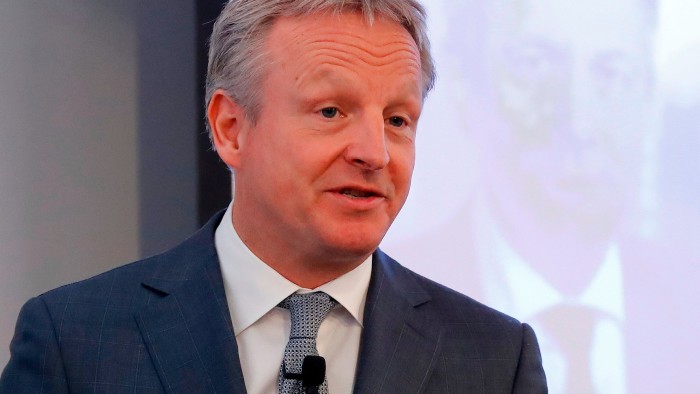Maarten Wetselaar gave the impression of a person in a hurry when he became chief executive of Spanish energy company Cepsa in January 2022.
About two months after his appointment, the former Shell executive unveiled an ambitious strategy to transform Compañía Española de Petróleos SA — or Spanish Petroleum Company — into a leading European renewable energy company.
And, just last month, in the latest manifestation of that strategy, Wetselaar announced the company’s new name and branding: Moeve. It was the clearest indication yet that transformation was taking a further step.
It was also a well-trodden route. Other fossil fuel energy companies, such as Norwegian’s Statoil, now known as Equinor, have opted to rename themselves to symbolise a departure from an old identity tied to hydrocarbons.
For Wetselaar, it was the culmination of a change that had started even before he had taken the CEO role. Speaking before the unveiling of the company’s new name, he said his appointment followed months of discussions with Cepsa’s shareholders.
He explained that he was then given “very, very deep” access to company data, enabling him and his team to quickly implement the new strategy, called Positive Motion, once he officially joined the firm.
“I had a pretty good feeling of what the strategy was going to be and, actually, one of the things that attracted me . . . was this chance to transform a company in one leadership cycle,” he told the Financial Times.
Moeve, which is owned by Abu Dhabi’s Mubadala and US private equity firm the Carlyle Group, is now just over two years into the new strategy — and it has already led to the builder of Spain’s first oil refinery selling about 70 per cent of its oil assets in that time.
Moeve’s route may have been travelled by others before, but it stands out for its ambition. It will help show the extent to which Europe’s oil and gas companies can transform themselves, and whether they can help the EU meet its 2050 target for net zero emissions.
In this, the company is benefiting from both the regulatory momentum and Spain’s geography.
“The strategy did not come out of the blue,” points out Mikhail Davydov, a credit analyst at S&P Global Ratings in Madrid. “It is supported by regulatory changes and the energy transition . . . They are trying to benefit from their positioning in a sunny and windy place where there is a lot of renewable energy.”
Ultimately, Moeve — which remains one of Europe’s largest refiners — is aiming to generate the majority of its profits from renewable sources by the end of this decade. To get there, it is investing €3bn in building two green hydrogen production facilities in southern Spain, which it says will produce as much as 300,000 tonnes of green hydrogen a year.
The company is also transforming its chemical production facilities towards more “sustainable solutions” — such as providing materials for the production of biodegradable detergents.
Pablo Fernández de Mosteyrín, a financial analyst at Spanish investment firm Renta4, notes that Moeve wants to go a step further than some of its peers as it seeks to be net positive on emissions after 2050. “These integrated oil companies have been focusing on gaining exposure to renewable energies,” he says.
Analysts have noted that Moeve’s greater ambition comes despite global oil majors scaling back their moves away from hydrocarbons, after the Russian invasion of Ukraine put energy security at the top of the political agenda.
Higher oil and gas prices since 2022 have led to investors favouring traditional oil and gas producers, too, and shunning companies that specialise in renewable energy, such as offshore wind. In the US, the election of oil-backer Donald Trump, who has threatened to overhaul Biden-era rules to curb emissions, may exacerbate this trend.
As a result, Moeve’s strategy is not without risks as it plans to invest about €8bn this decade on products that now face investor scepticism. Failure could have negative implications for its debt and its credit rating.
“This strategy might position [Moeve] as one of the first movers, and so one of the more successful players,” says Alexander Griaznov, a credit analyst in S&P’s Europe, Middle East and Africa commodities team. “But, equally, if those markets do not develop the way the company wants, it might of course bring them into a position where their cash flows will be even more volatile.”
A bullish Wetselaar appears unconcerned. In October, when announcing the company’s rebrand, he told staff that Moeve’s “unstoppable transformation” was based on the “reality” of the energy transition and would not be derailed by short-term political considerations.
That echoed his previous comments to the FT that, being a private company, Moeve (still called Cepsa then) could look beyond the short term — unlike those with multiple investors looking for a “fossil fuel return”.
“Fundamentally, there is no other future than replacing fossil molecules with green molecules,” he said at the time. “The risk profile of doing it as quickly as we do is more suitable to a company in private hands with two shareholders, than to a company in public hands with 2mn shareholders.”
Read the full article here

